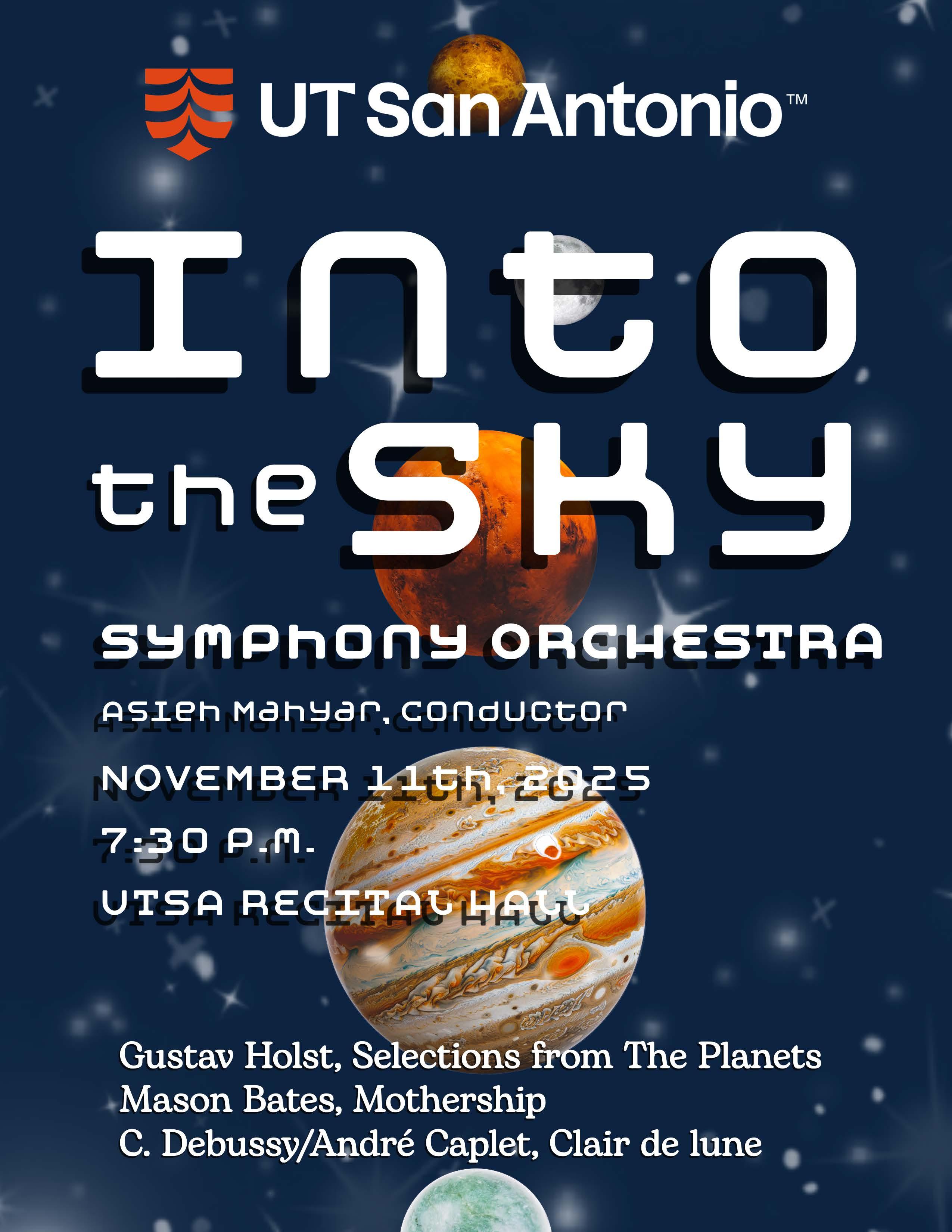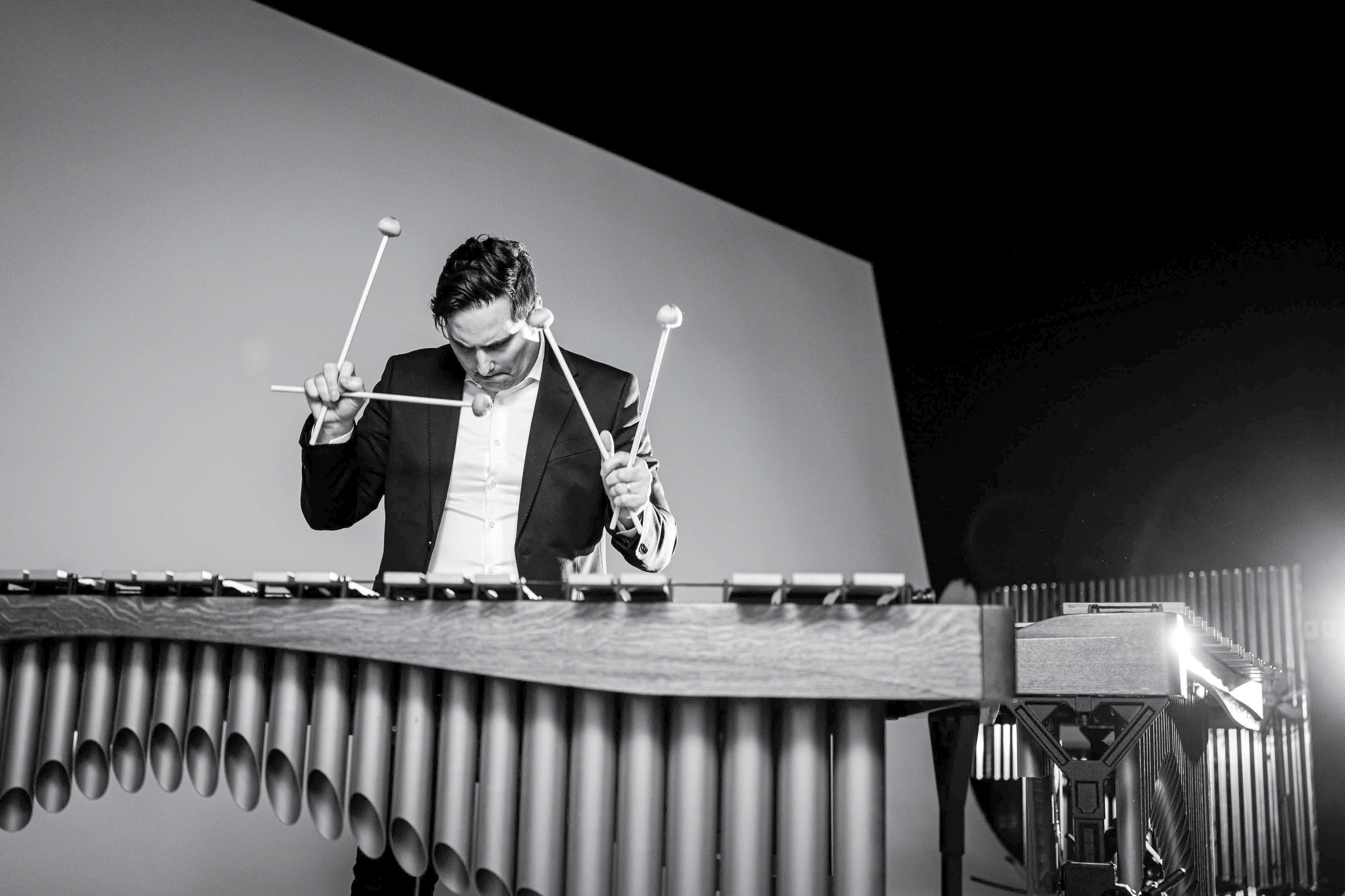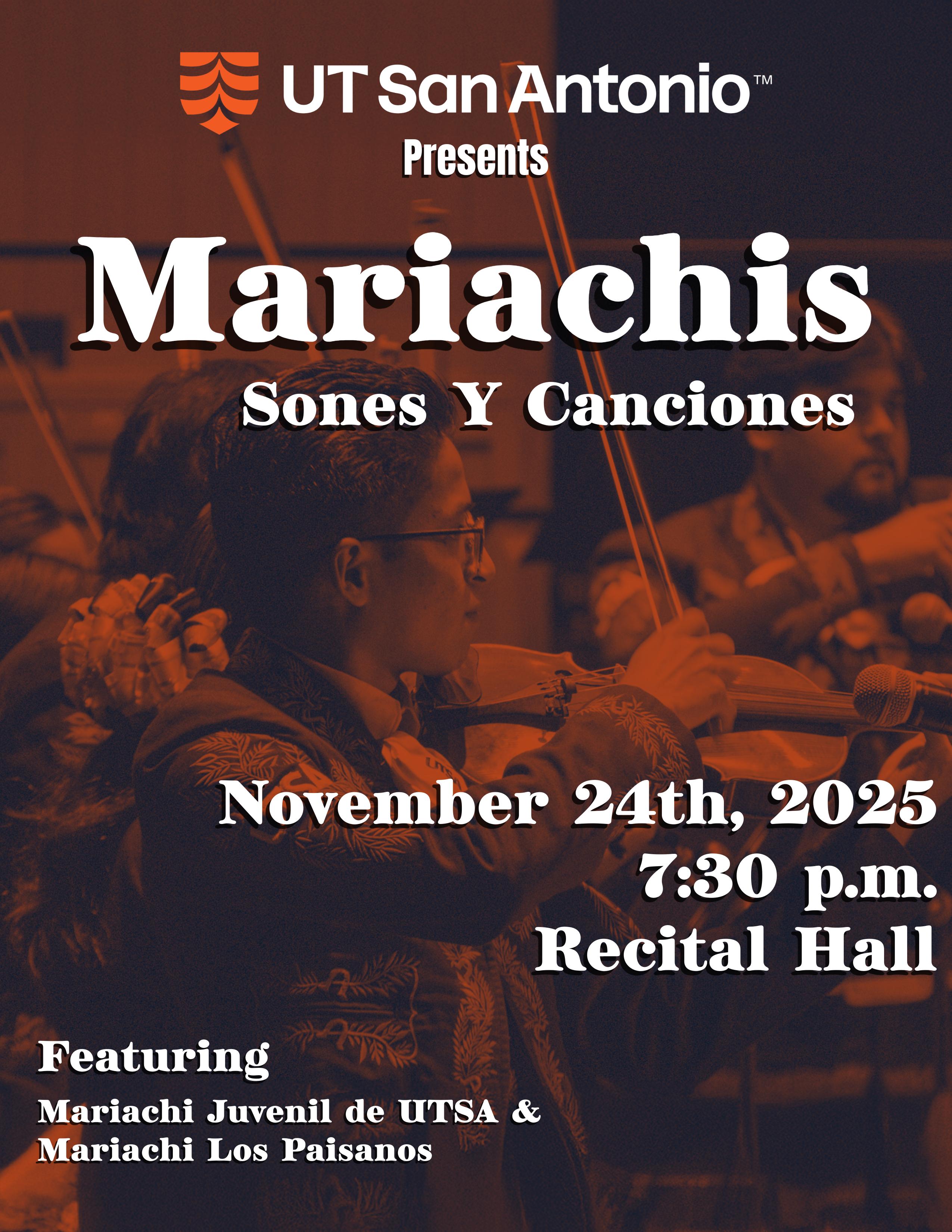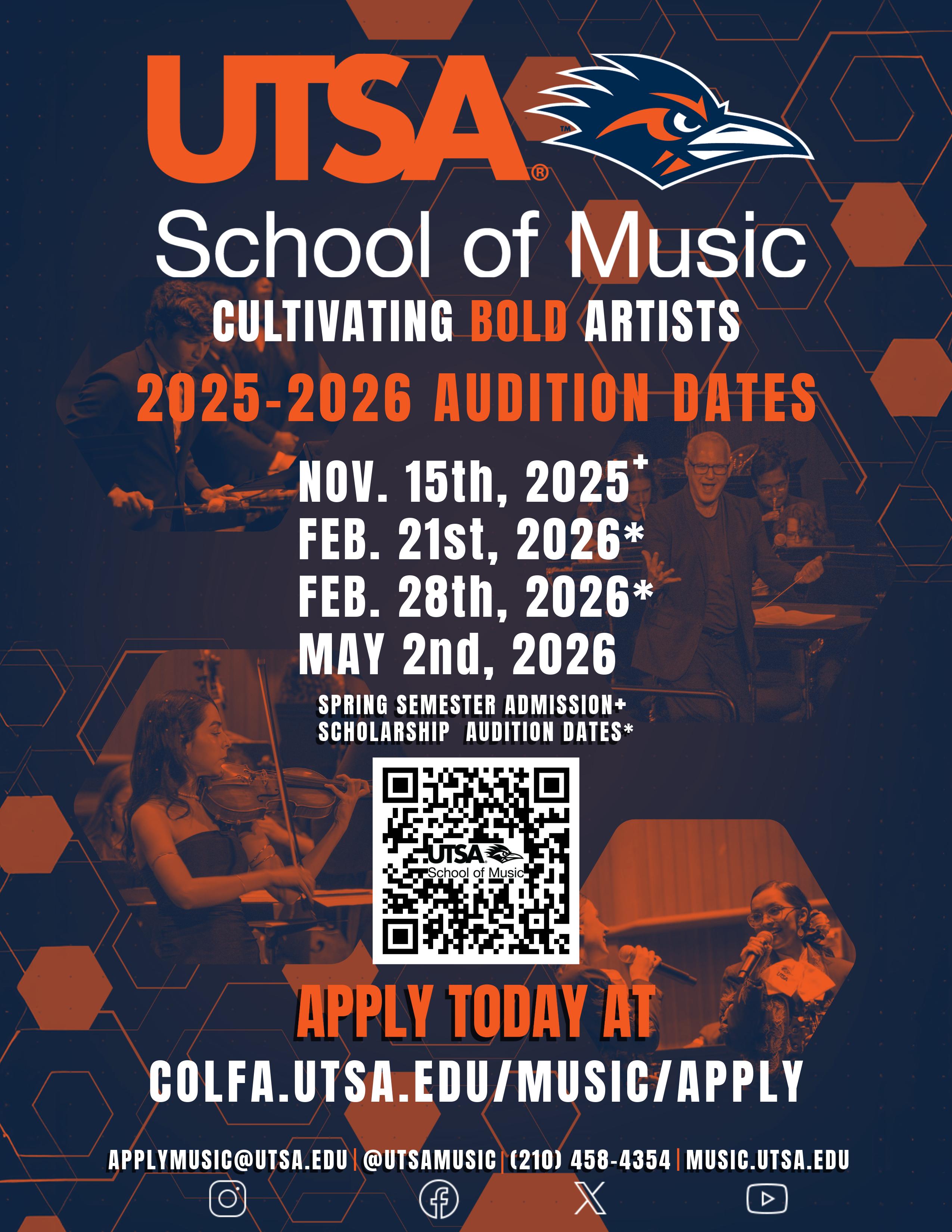
THE UNIVERSITY OF TEXAS AT SAN ANTONIO COLLEGE OF LIBERAL AND FINE ARTS SCHOOL OF MUSIC PRESENTS
The University of Texas at San Antonio Symphonic Orchestra

Asieh Mahyar Conductor Program “Into the Sky”
Mothership (2010) Mason Bates (b. 1977)
Clair de lune, from Suite bergamasque
Claude Debussy (1862-1918)
Arr. André Caplet (1878-1925)
The Planets (1914-1916) Gustav Holst (1874-1934)
I.Mars, the Bringer of War
II.Venus, the Bringer of Peace
IV.Jupiter, the Bringer of Jollity
VI.Uranus, the Magician
Tuesday, Nov 11, 2025, 7:30 pm UTSA Music Recital Hall
Flutes/ Piccolos
Jazmine Dearlove + Hannah Benitez ^ Lauren Garcia + Brianna Martinez +
Oboes
Makayla Aguilar + Samuel Coleman ^
Logan Odom+
Clarinets/Bass Clarinets
Ethan Aguilar ^ Sarah Hamm ^ Kenedy Lerma + Isabella Miranda +
Bassoons
Leondro Hernandez ^ Walter Jordan + Katherine Martz ^ Jared Worman, C. Bn ^
Horns
Brandon Bayer + Joel Chi ^ Caleb Jones ^ Noe Loera ^
Francis Maille-Romero + Andrew Ramirez ^+
Trumpets
Ivan Lorduy Camargo ^+ Madeline Garcia
Gustavo Medrano + Daniel Vazquez
Trombones
Bradley Bolton + Jayden Zunker-Treviño + Javier Lopez, Bass
Symphony Orchestra Personnel
Euphonium
Finley Farrar
Tuba
Matthew Bruns
Electronica
Rebecca Palmer
Perc
Gregory Felter + Adam Jackson
Juan Martinez
Rebecca Palmer
Antonio Rios ^ Ivan Ventura ^
Harp
Nathan Sharplin
Sonja Westberg White
Keyboard
Alesia Bridgewski
Organ
Ethan R. Aguilar
Violin I
Keith Beene *
Karyl De Guzman *
Javier Martinez
Daniel Constantino
Joseph Buechner
Akemi Nunez-Martinez
Josette Garcia
Evelyn Escalon
Daniel Rocha
Malachi Landin
Mailyn Armijo-Trinidad
Kayla Strizu
Isaac Cortez
Christal Martinez
Violin II
Harmony Grace + Jennivie Bui + Elena Castillo
Alyssa Perez
Alvin Philip
Elijah Boston
Jamal McLamb
Elise Flores
Jake Garcia
Cynthia Elias
Benny Elrod
Nicole Barragan
Jaylin Cahee
Viola
Bryan Echeveste + Joaquin Gomez + Abraham Abergo
Ethen Greenberg
GuadaLupe Lopez
Cello
Natalie Esquivel + Leyton Leslie + Isaiah Valdez
Emily Lo
Katherine Beebe
Benjamin Wood
Valerie Hernandez
Ethan Barrera
Double Bass
Heri Ayma +
Demtric Williams + Leonardo Huerta Lima
Damien Peters
Fletcher Lowe
Pedro Badillo-Garcia
Sebastian Ortiz
Staff
Eva Ayala, Music Librarian
Jared Worman, Music Librarian
Isaiah Valdez, Personnel Manager
Elena Castillo, Social Media Manager
Akemi Nunez-Martinez, Social Media Manager
Emily Lo, Stage Manager
Fletcher Lowe, Stage Manager
Javier Martinez, Stage Manager
*Denotes Concert Master/Co-Concert Master
+Denotes Principal
^Denotes Assisting Musician
WBP roster is listed alphabetically
String roster is listed by seat
Special thanks to the following for their ongoing support and dedication to the UTSA Symphony Orchestra:
Dr. Glenn Martinez, Dean, College of Liberal and Fine Arts
Dr. Tracy Cowden, Director, School of Music
Dr. Stacey Davis, Associate Director, School of Music
Dr. Kasandra Keeling, Associate Director, School of Music
Naomy Ybarra, Administrative Services Officer
Steven Hill, Administrative Associate
Jared Davis, Senior Events Manager
Joey Berrios, Marketing Coordinator
Rico Gomez, Music Program Specialist
Prof. Ron Ellis, Director of Bands
Dr. John Zarco, Director of Instrumental Ensembles
Prof. Hector Garcia, Assistant Director of Athletic Bands
Dr. Nicole Cherry, String Area Coordinator
Prof. Sherry Rubins and Prof. Paul Millette, Percussion Area Faculty
Dr. Rachel Woolf and Dr. Oswaldo Zapata, Woodwind and Brass Area Coordinators
Dr. Yoojin Muhn, Director of Choral Activities
Dr. Jordan Boyd, Assistant Director of Choral Activities
UTSA School of Music Faculty
Eva Ayala and Jared Worman, School of Music Librarians
UTSA Symphony Orchestra Managers
Conductor
Asieh Mahyar is the Director of Orchestral Activities and Assistant Professor of Music at the University of Texas at San Antonio, where she also teaches graduate and undergraduate courses in conducting.
Previously, she served as the Director of Orchestral Studies at Pacific Lutheran University in Washington, Conductor of the Symphony Orchestra at the West Seattle Community Orchestras (WSCO), and has guest conducted orchestras across the country. Active as a clinician and adjudicator, she has collaborated with youth and high school orchestras, festivals, and conferences throughout the United States, including the 2024 Washington Music Educators Association (WMEA) Conference.
A Doctor of Musical Arts candidate (ABD) in Orchestral Conducting at Michigan State University, Mahyar holds a Master of Music in Orchestral Conducting from the University of Massachusetts Amherst and a Bachelor of Music with Honors in Choral Conducting from the Komitas State Conservatory in Yerevan, Armenia.
Follow us:
Webpage: UT San Antonio Symphony Orchestra
Instagram: @ UTSAOrchestras
Facebook: UTSAOrchestras
School of music social media and webpage links (TBA)
Program Notes
Mothership
The mothership floats high above an orchestra pulsing rapidly with a heart of techno. At several moments in the piece, various soloists dock with the mothership, dropping in with solos both virtuosic and lyrical. The work was commissioned by Michael Tilson Thomas and the YouTube Symphony, which asked about the possibility of integrating improvisation.
The piece follows the form of a scherzo with double trio. But while symphonic scherzos historically play with dance rhythms such as the waltz, Mothership looks to 21st Century electronic dance music to enliven its journey. The brief solos can be played as written or improvised.
- Program notes from the composer
Clair de Lune, from suite bergamasque
With his compatriot Ravel, Claude Debussy is considered the father of Impressionism in music. The dates are certainly right; Debussy was born in 1862, and Impressionism in painting began to take shape in the 1870s. But what does Impressionism in music mean? In painting we can see how the fleeting impression is captured, how light and air fill the canvas rather than an arrangement of solid objects. By now we are comfortable viewing the paintings of Renoir, Monet and their colleagues, and their works have gained such widespread popularity that we must remind ourselves how Impressionist paintings shocked the eye back in the 1870s: The colors seemed strangely bright, the shadowy neutrals were gone, and the paintings rendered impressions of light rather than the world of objects in space. Yet somehow that world materializes before us as we simply relax and look.
Though Debussy edged away from traditional major and minor keys, he did not eliminate traditional tonal centers, but “blurred” them. Employing exotic harmonies and the “perfect” scale comprised only of whole steps – with only seven integral notes in play, we can’t even use the term “octave” –Debussy’s music accustoms us to tonal evocations of mood and atmosphere that function as light does in Impressionist paintings. His instrumental color, texture, and meandering harmonies ignore traditional combinations. Where Impressionist paintings leave the world of objects behind, Impressionist music goes beyond earlier conventions of harmonic and rhythmic development, moving from one bar to the next in a spontaneous, organic flow.
First, let’s note the masterful orchestral arrangement by André Caplet. A contemporary of Ravel and Debussy who won the Prix du Rome one year ahead of Ravel, Caplet worked closely with Debussy, even acting as his translator at times. In orchestrating the suite, Caplet had to live up to the French reputation for masterful orchestration; this work and his orchestration of the Children’s
Corner Suite remain Caplet’s most frequently programmed arrangements, with “Clair de Lune” his single most popular movement by far.
Though music dictionaries trace the term “bergamasque” to rustic dances from the Italian town of Bergamo, the sound of “Clair de Lune” is anything but rustic. Its sound is elegant and luminous. Moonlight has been an irresistible subject for composers, and this movement is one of its most famous evocations – along with Beethoven’s “Moonlight” sonata for piano and the melody from Rachmaninoff’s second piano concerto which became the pop song “Full Moon and Empty Arms.” What we hear in these four beautiful minutes seems to suspend time and movement – hardly the stuff of dance. It remains rooted in its opening key of D-flat major, budging only for an unexpected modulation into E major – distant in harmonic terms, but very close on the scale.
If you haven’t yet heard “Clair de Lune” in the concert hall or on recording, you may have heard it at the movies – in films such as Giant (1956), Casino Royale (1967) and Ocean’s Eleven (2001).
-Program notes from UTAH Symphony
The Planets
The Planets, composed between 1914 and 1916, is a suite of seven movements. Holst's starting point for the music was the astrological character of each planet, though his interest in astrology went no deeper than its musical suggestiveness. His daughter wrote that once the underlying idea had been formulated 'he let the music have its way with him'. There was, therefore, no programme for the suite, and the composer himself pointed out that it has no connection with the deities of classical mythology. The many clues to the meaning of the music are the subjects of the individual movements.
MARS, the bringer of war. Three musical ideas are used to create this martial piece: (1) a brutally rhythmic figure of five beats relentlessly hammered out, (2) a principal theme in triads moving by chromatic steps with no true harmonic purpose; (3) a second theme consisting of a tattoo in the tenor tuba answered by a flourish of trumpets. There is no glory, no heroism, no tragedy in this music. It is entirely inhuman. Not even death is in it, for Mars is as insensitive to death as to life. War is a senseless, mechanized horror is Holst's real subject here.
VENUS, the bringer of peace. She is announced by four ascending notes in the solo horn and a sequence of converging chords in the flutes and oboes. Most of her music lies, symbolically, in the middle and upper registers of the instruments; and harps, celeste, and glockenspiel further characterize her heavenly nature. In addition, there are beautiful melodies for her in the solo violin and oboe. Though this is music of surpassing serenity, it is not simple in harmony, texture or orchestral sonority. One cannot help but observe how fitting it is that the state of peace be described in complex terms, in contrast to the complicity of the depiction of war.
JUPITER, the bringer of jollity. The exuberance of this movement shows itself not only in its tempo and rhythm but also in the multiplicity of subjects. You can count four, five or six of them, depending on whether you divide the first two into their component parts - they do behave like independent themes. Jupiter might well be designated as 'the English movement' because it shows how profoundly Holst was influenced by the folk music of his country. Certainly this is rustic English, music for a fair; there are crowds of people in it and infinite good spirits. The grand tune that ends the parade of themes has become the setting for a patriotic hymn with the words 'I vow to thee my country'.
URANUS, the magician. You can take as the figure of Uranus almost any magician you have ever seen in opera, drama or vaudeville - preferably one with the tall pointed hat studded with stars, the flowing blue robe with voluminous sleeves, and the silver want. He is invoked by Holst with a triple invocation, and he begins to show his tricks immediately. His repertoire is vast and astonishing and at the climax of his demonstration he struts around pompously to a pompous tune. By way of encore he makes some mysterious incantations, suddenly (one guesses from the music) envelops himself in flames - and disappears.
-Program notes from Wise Classical Music.
















